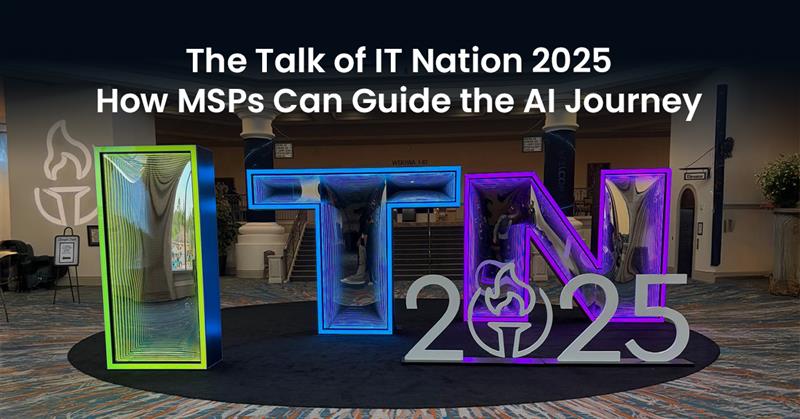If you’re running an MSP, you already know the drill. Your security team is drowning in alerts, your analysts are burned out, and somehow threats still slip through the cracks. Sound familiar?
Here’s the reality: According to the SANS 2024 SOC Survey, 70% of SOC analysts with five years’ experience or less leave their role within three years. That’s not just a retention problem. That’s your institutional knowledge walking out the door because people are exhausted from chasing ghosts. SOC automation isn’t just another tech buzzword. It’s the lifeline modern MSPs need to deliver exceptional SOC Services for MSP clients without sacrificing quality or your team’s sanity.
Let’s cut through the noise and talk about what SOC automation really is, why it matters, and how you can leverage it to transform your security operations.
What is SOC Automation for Modern MSPs?
SOC automation uses artificial intelligence, machine learning, and orchestration platforms to handle repetitive security tasks that traditionally consumed your analysts’ time. Think of it as giving your security team a highly intelligent assistant that never sleeps, never gets tired, and processes thousands of alerts simultaneously.
At its core, security operations automation combines several powerful components:
- Automated playbooks that execute predefined responses to common threats
- SIEM integration that aggregates and correlates security data across your entire infrastructure
- AI-driven threat detection that identifies patterns humans might miss
- Orchestration platforms (SOAR) that connect your security tools and automate workflows
- Machine learning algorithms that continuously improve detection accuracy
The difference between traditional SOC operations and SOC automation is night and day. Instead of manually investigating every alert, your team focuses on genuine threats while automation handles the heavy lifting.
Why Security Operations Automation Matters in 2025
Let’s talk numbers. According to Osterman Research, almost 90% of SOCs are overwhelmed by backlogs and false positives, with more than 80% of analysts reporting feeling constantly behind.
Think about what that means for your MSP. Your analysts are spending more time triaging alerts than actually hunting threats. They’re burning out. And when they burn out, they leave, taking years of experience with them.
The threat landscape isn’t getting easier, either. Cybercriminals are more sophisticated, attack surfaces are expanding, and regulatory requirements keep getting stricter. Manual security operations simply can’t keep pace with this reality.
Your analysts are dealing with alert fatigue, false positives, and an increasingly complex threat environment. When security teams become desensitized to alerts because there are just too many of them, the likelihood of missing or ignoring critical alerts increases dramatically. This can result in breaches going undetected for extended periods, allowing attackers to dwell and cause extensive damage.
SOC automation solves this by dramatically reducing the noise and allowing your team to do what they do best: think strategically and hunt real threats.
Understanding Your SOC Workflow and Automation Architecture
Before you can automate effectively, you need to understand how incident response automation fits into your existing SOC workflow. Here’s how the pieces connect:
- Data Collection and Normalization: Your automation platform ingests security events from firewalls, endpoints, cloud services, and network devices. It normalizes this data into a consistent format, regardless of where it originated.
- Automated Correlation and Analysis: Instead of manually connecting the dots between 50 different alerts, your automation platform correlates events, enriches them with threat intelligence, and identifies legitimate security incidents.
- Threat Intelligence Integration: Real-time feeds from multiple sources provide context about IP addresses, domains, and file hashes. This happens automatically, giving your analysts immediate context when they review an alert.
Incident Response Automation: From Detection to Resolution
This is where SOC automation really shines. When a genuine threat is detected, your automated SOC workflow springs into action:
- Automated triage immediately assesses the alert severity based on predefined criteria
- Threat enrichment pulls in additional context from threat intelligence platforms
- Playbook execution initiates containment actions like isolating infected endpoints or blocking malicious IPs
- Documentation automatically logs every action for compliance and post-incident analysis
The entire process that once took hours now happens in minutes or seconds. Your analysts receive a fully enriched, properly prioritized incident with recommended remediation steps already in progress.
How SOC Automation Transforms MSP SOC Efficiency
Let’s talk about the tangible benefits that actually move the needle for your MSP:
- Accelerated Threat Detection and Response: Without automation, detecting and responding to threats can take days or weeks. With incident response automation, you’re looking at detection and containment in minutes, not months. That’s the difference between a minor incident and a catastrophic breach.
- Dramatic Reduction in False Positives: More than 50% of alerts are false positives in many organizations. Smart automation learns which alerts matter and which don’t, filtering out the noise so your analysts can focus on real threats.
- Enhanced Analyst Productivity: When your team isn’t buried in alert triage, they can conduct proactive threat hunting, refine security policies, and work on strategic initiatives that actually improve your clients’ security posture.
Security Operations Automation ROI and Business Impact
Here’s where CFOs start paying attention. The ROI on SOC automation is substantial and measurable.
But the real value goes beyond cost savings:
- Scalability: Handle 5x more clients without proportionally increasing headcount
- Consistency: Every client gets the same high-quality response, every time
- Compliance: Automated documentation and audit trails make compliance reporting painless
- 24/7 Coverage: Your automated systems never sleep, providing round-the-clock protection
Real-world implementations show impressive results. Organizations that implement SOC automation typically see 40-60% reduction in manual effort, faster incident response times, and the ability to scale security services without proportional staff increases.
Top Incident Response Automation Scenarios
Let’s get practical. What should you automate first? Focus on high-volume, repetitive tasks that deliver immediate value:
Phishing Email Triage and Remediation:
- Automatically analyze reported phishing emails
- Check URLs and attachments against threat intelligence
- Remove malicious emails from all mailboxes
- Block sender domains at the gateway
Malware and Ransomware Detection:
- Isolate infected endpoints automatically
- Terminate malicious processes
- Roll back file encryption using backup snapshots
- Alert your team with full incident context
Suspicious Login Activity:
- Detect impossible travel scenarios
- Flag credential stuffing attempts
- Automatically disable compromised accounts
- Trigger multi-factor authentication challenges
Optimizing Your SOC Workflow with Intelligent Automation
Don’t stop at reactive responses. Use automation for proactive security operations:
- Vulnerability Management: Automatically scan for vulnerabilities, prioritize based on exploitability and asset criticality, and generate remediation tickets.
- Threat Hunting: Let automation continuously search for indicators of compromise across your environment while your analysts investigate the most promising leads.
- Compliance Reporting: Automatically generate audit-ready reports that demonstrate your security controls are working as intended.
Building Your Security Operations Automation Strategy
Ready to get started? Here’s your roadmap:
- Start with Quick Wins: Don’t try to automate everything on day one. Pick 2-3 high-volume, clearly defined processes. Common targets include alert triage, phishing response, and malware containment.
- Map Your Current Workflows: Document exactly how your team handles common security incidents today. Identify the repetitive steps that consume the most time.
- Assess Your Automation Maturity: Be honest about where you are. Most MSPs start at Level 1 (manual processes) and work toward Level 5 (fully autonomous operations).
Essential Tools and Technologies for MSP SOC Efficiency
Your automation stack should include:
- SOAR Platforms: These platforms orchestrate your security tools and execute automated playbooks. They’re the brain of your SOC automation strategy.
- SIEM Integration: Your automation is only as good as the data it processes. Ensure your SIEM feeds clean, normalized data to your automation platform.
- AI and Machine Learning: Look for platforms that continuously learn from your environment and improve detection accuracy over time.
- API Connectivity: Everything needs to talk to everything else. Prioritize solutions with robust API support for seamless integration.
Overcoming SOC Automation Challenges
Let’s address the elephant in the room. SOC automation isn’t plug-and-play, and you’ll face obstacles:
- Integration Complexity: You’re probably running dozens of security tools. Getting them all to work together requires planning and effort.
- Customization Requirements: Your clients have different risk profiles, compliance requirements, and security tools. Your automation needs to flex accordingly.
- Balancing Automation with Human Oversight: Don’t automate yourself into a corner. Critical decisions still require human judgment. Build in appropriate checkpoints.
- Managing False Negatives: While you’re reducing false positives, make sure your automation isn’t missing real threats by being too aggressive with filtering.
The key is starting small, proving value, and expanding gradually.
Conclusion: Elevate Your MSP with IT By Design’s SOC Services
The challenges are clear: overwhelming alert volumes, analyst burnout, and increasingly sophisticated cyber threats demand more than manual processes can deliver. SOC automation isn’t just an operational improvement. It’s a competitive necessity for MSPs looking to deliver exceptional security operations automation at scale.
But here’s the thing: building and maintaining an automated SOC from scratch is complex, time-consuming, and expensive. That’s where IT By Design’s comprehensive SOC Services come in.
We provide turnkey incident response automation solutions specifically designed for MSPs. Our platform combines cutting-edge AI-driven automation with expert 24/7 monitoring to optimize your SOC workflow and dramatically improve MSP SOC efficiency. We handle the complexity of integration, customization, and continuous optimization so you can focus on growing your business.
Why choose IT By Design’s SOC Services for your MSP?
- Pre-built playbooks tailored for MSP environments that address the most common security scenarios your clients face
- Seamless integration with your existing security stack without rip-and-replace disruption
- Dedicated support from SOC experts who understand the unique challenges MSPs face
- Proven track record of reducing MTTR by up to 70% while increasing client satisfaction
- Scalable architecture that grows with your client base without proportional cost increases
- White-label capabilities so you can deliver premium security services under your brand
Don’t let manual security operations hold your MSP back. While your competitors are still drowning in alert fatigue, you could be delivering world-class security operations automation that delights your clients and protects their businesses.
Schedule a consultation with IT By Design today and discover how our SOC automation solutions can transform your security operations, reduce analyst burnout, and accelerate your growth. We’ll show you exactly how automated security operations can become your competitive advantage.
Your clients deserve better protection. Your analysts deserve better tools. Your business deserves better results. IT By Design’s SOC Services deliver all three.
Frequently Asked Questions About SOC Automation
Q. Does SOC automation replace security analysts?
A. No. Automation handles repetitive tasks, freeing analysts to focus on complex threats and strategic security initiatives that require human expertise and judgment.
Q. What tasks can be automated in a SOC?
A. Alert triage, threat intelligence enrichment, log analysis, phishing response, malware containment, vulnerability scanning, and incident documentation are all excellent candidates for automation.
Q. How long does it take to implement SOC automation?
A. Implementation timelines vary from weeks to months depending on your infrastructure complexity and organizational readiness. Start with quick wins before tackling complex workflows.
Q. What is the ROI of SOC automation for MSPs?
A. MSPs typically see 40-60% reduction in manual effort, faster incident response times, improved client satisfaction, and the ability to scale security services without proportional staff increases.








